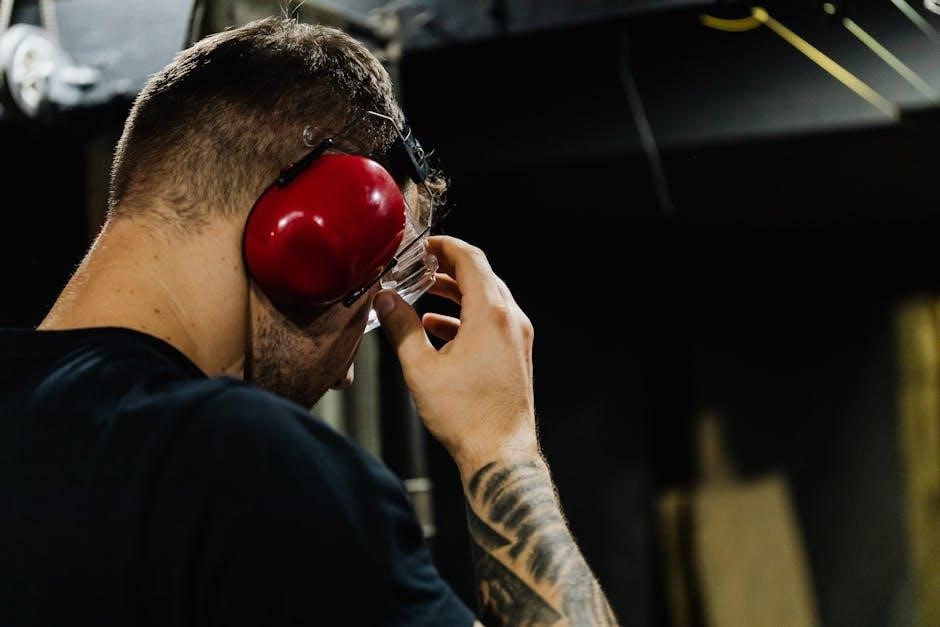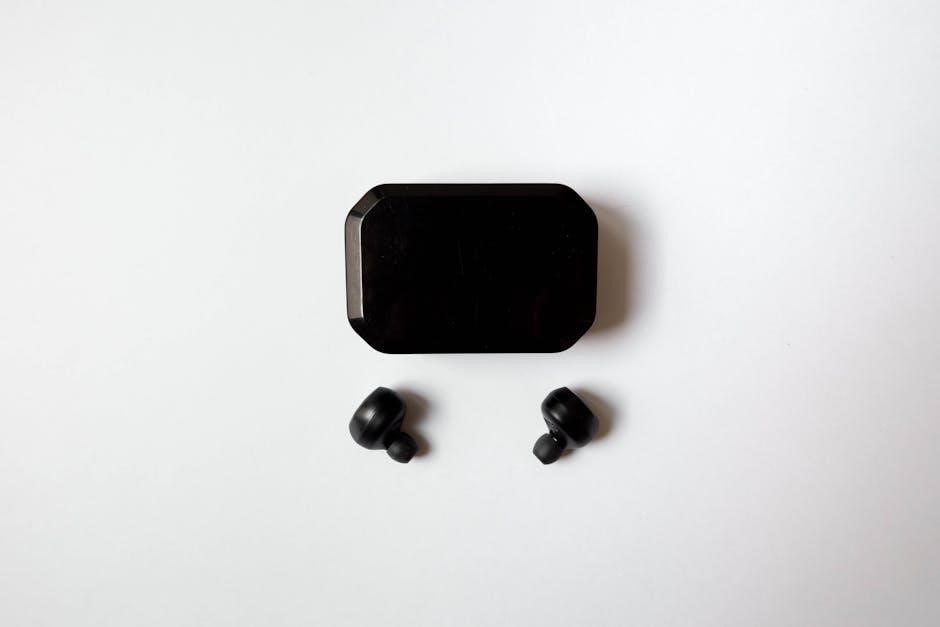Plantronics Voyager Bluetooth Headset Manual: A Comprehensive Guide
Welcome! This guide offers quick access to Plantronics Voyager headset instructions․ Explore setup, pairing, charging, and troubleshooting․ Learn about voice prompts, Plantronics Hub, and advanced features for optimal use․

Overview of the Plantronics Voyager Series
The Plantronics Voyager series represents a premium line of Bluetooth headsets designed for professionals and individuals who demand exceptional audio quality, comfort, and reliability in their communication devices․ These headsets are engineered to excel in various environments, from bustling offices to remote work setups, ensuring clear and consistent communication regardless of background noise or location․ The series encompasses several models, each with its unique features and capabilities, catering to diverse user needs and preferences․ Key attributes across the Voyager series include advanced noise cancellation technology, which effectively minimizes distractions and enhances call clarity, allowing users to focus on their conversations without external interference․ Ergonomic designs prioritize comfort, enabling extended wear without fatigue, a crucial factor for those who spend long hours on calls or in meetings․ Intuitive controls and voice prompts simplify operation, making it easy to manage calls, adjust volume, and access other essential functions․ Furthermore, the Voyager series often incorporates smart sensor technology, which automatically detects when the headset is worn, enabling features such as automatic call answering and pausing of audio playback․ Integration with the Plantronics Hub software provides additional customization options and firmware updates, ensuring optimal performance and access to the latest features․ Models like the Voyager 5200 and Voyager 4300 series are particularly popular for their exceptional noise cancellation and all-day comfort, making them ideal for professionals in demanding work environments․ Whether you’re working from home, traveling, or in a busy office, the Plantronics Voyager series offers a versatile and reliable communication solution․

Pairing Your Plantronics Voyager Headset
Pairing your Plantronics Voyager headset with your smartphone, tablet, or computer is a straightforward process that establishes a wireless connection, allowing you to enjoy hands-free communication and audio streaming․ Before you begin, ensure that your headset is sufficiently charged and that Bluetooth is enabled on the device you wish to pair with․ The initial pairing process typically involves placing the headset into pairing mode․ This is usually achieved by pressing and holding the power button or a dedicated Bluetooth button until the LED indicator on the headset begins to flash in a distinctive pattern, often blue and red, indicating that it is discoverable․ On your device, navigate to the Bluetooth settings menu and initiate a search for available devices․ Your Plantronics Voyager headset should appear in the list of available devices․ Select your headset from the list, and if prompted, enter the pairing code, which is commonly “0000” (four zeros)․ Once the pairing is successful, the LED indicator on the headset will usually turn solid blue or emit a different signal to confirm the connection․ Some Voyager models also provide voice prompts that announce the successful pairing․ For subsequent connections, the headset will typically connect automatically to the last paired device when both are within range and Bluetooth is enabled․ If you encounter any issues during the pairing process, consult the user manual for your specific Voyager model for detailed instructions and troubleshooting tips․ The Plantronics Hub application can also assist with pairing and managing connections․ Remember to unpair or “forget” the headset from your device’s Bluetooth settings if you intend to pair it with a different device or if you are experiencing persistent connectivity problems․ Properly pairing your headset ensures a stable and reliable connection for calls and audio․
Charging the Headset and Charging Case
Ensuring your Plantronics Voyager headset is adequately charged is crucial for uninterrupted use throughout the day․ The charging process is simple and convenient, and most Voyager models come with a charging case that provides additional battery life on the go․ To charge the headset, locate the charging port on the device․ This is typically a micro-USB or USB-C port․ Connect the provided USB cable to the charging port and plug the other end into a USB power source, such as a computer, wall adapter, or car charger․ The LED indicator on the headset will illuminate to indicate that it is charging․ The color and behavior of the LED will vary depending on the model, but it usually turns solid red or amber while charging and changes to green or turns off when fully charged․ Allow the headset to charge completely, which may take several hours, depending on the battery level and the charging source․ The charging case, if included, serves as both a protective storage unit and a portable charger․ To charge the case, connect it to a USB power source using the provided cable․ The LEDs on the case will indicate the charging status․ To charge the headset using the charging case, simply place the headset inside the case, ensuring that it is properly aligned with the charging contacts․ The case will automatically begin charging the headset․ The LEDs on the case will indicate the charging status of both the case and the headset․ Regularly charging both the headset and the charging case ensures that you always have ample power for calls and audio streaming․ It is recommended to fully charge the devices before their first use and to avoid completely draining the battery to prolong its lifespan․ Refer to the user manual for your specific Voyager model for detailed charging instructions and information on battery life․
Understanding LED Indicators and Voice Prompts

Plantronics Voyager headsets utilize both LED indicators and voice prompts to communicate important information to the user․ These cues provide real-time updates on the headset’s status, including battery level, connection status, call activity, and more․ Understanding these indicators and prompts is essential for effectively managing your headset and maximizing its functionality․ LED indicators are small lights on the headset that illuminate in different colors and patterns to convey specific information․ For example, a solid blue LED typically indicates that the headset is connected to a device via Bluetooth, while a flashing red LED may indicate a low battery․ The specific meanings of the LED indicators vary depending on the Voyager model, so it is important to consult the user manual for detailed explanations․ Voice prompts are audible messages that the headset plays to provide information or instructions․ These prompts can announce incoming calls, indicate when the headset is connected or disconnected from a device, provide battery level updates, and confirm when certain functions are activated or deactivated․ The voice prompts are designed to be clear and concise, allowing you to quickly understand the headset’s status without having to look at it․ You can often customize the language and volume of the voice prompts through the Plantronics Hub application․ By paying attention to the LED indicators and voice prompts, you can stay informed about the status of your Plantronics Voyager headset and ensure that it is functioning properly․ This allows you to manage calls, adjust settings, and troubleshoot issues more effectively․ Refer to the user manual for a comprehensive list of LED indicator meanings and voice prompt messages specific to your Voyager model․

Using the Plantronics Hub Application
The Plantronics Hub application is a powerful software tool designed to enhance your experience with your Plantronics Voyager headset․ Available for both desktop and mobile devices, Plantronics Hub provides a centralized interface for managing your headset settings, updating firmware, accessing support resources, and discovering new features․ To get started, download and install the Plantronics Hub application from the Plantronics website (plantronics․com/software) or your device’s app store․ Once installed, launch the application and connect your Voyager headset to your computer or mobile device via Bluetooth or USB․ The application will automatically detect your headset and display its current status, including battery level, connection status, and firmware version․ Plantronics Hub allows you to customize a wide range of headset settings to suit your preferences․ You can adjust the volume levels, configure call management options, enable or disable sensors, and personalize voice prompts; The application also provides access to advanced features such as Find MyHeadset, which can help you locate a misplaced headset, and SoundGuard technology, which protects your hearing from loud noises․ Keeping your headset’s firmware up-to-date is crucial for optimal performance and access to the latest features․ Plantronics Hub makes it easy to check for and install firmware updates with just a few clicks․ The application also provides access to support resources, including user manuals, FAQs, and troubleshooting guides․ If you encounter any issues with your headset, Plantronics Hub can help you diagnose and resolve them quickly․ By utilizing the Plantronics Hub application, you can unlock the full potential of your Plantronics Voyager headset and enjoy a more personalized and seamless user experience․ Regular use of the application ensures that your headset is always up-to-date, configured to your liking, and ready to perform at its best․
Basic Operations: Calls, Volume, and Mute
Understanding the basic operations of your Plantronics Voyager headset is essential for seamless communication․ These core functionalities include managing calls, adjusting volume, and utilizing the mute feature․ Mastering these controls will allow you to efficiently handle your calls and ensure clear, professional communication in any environment․ To answer an incoming call, simply press the call control button located on your headset․ This button is typically found on the side or top of the earpiece․ A single press will answer the call, allowing you to begin your conversation․ To end a call, press the same call control button again․ This will disconnect the call and return the headset to its idle state․ If you prefer to ignore an incoming call, you can press and hold the call control button for a few seconds․ This will send the call to voicemail (if configured) or simply disconnect the caller․ Adjusting the volume on your Plantronics Voyager headset is straightforward․ Most models feature volume control buttons located on the side of the headset․ Press the “+” button to increase the volume and the “-” button to decrease it․ You can also adjust the volume through your connected device (smartphone, computer, etc․)․ The mute function is crucial for maintaining privacy during calls․ To mute your microphone, press the dedicated mute button on the headset․ This button is usually located on the side or bottom of the earpiece and may be indicated by a microphone icon․ When muted, the other party will not be able to hear you․ To unmute, simply press the mute button again․ Some Voyager headsets also offer dynamic mute alert, which reminds you if you start speaking while the microphone is muted․ This feature prevents accidental moments of silence and ensures that you are always heard when you intend to be․ By familiarizing yourself with these basic operations – call management, volume adjustment, and mute control – you can confidently and effectively use your Plantronics Voyager headset for all your communication needs․ These simple yet vital functions will streamline your calls and enhance your overall experience․
Advanced Features: Sensors and Audio Streaming
Plantronics Voyager headsets are equipped with advanced features that enhance user experience beyond basic call functions․ Two notable features are smart sensors and audio streaming capabilities․ These functionalities provide added convenience, automation, and entertainment options․ Smart sensors in Voyager headsets intelligently detect when the headset is being worn․ This enables automatic call answering when the headset is placed on your ear and automatic call muting when the headset is removed․ This sensor technology streamlines call management and allows for hands-free operation․ The sensors can also pause or resume audio streaming automatically when the headset is taken off or put on, ensuring uninterrupted listening․ Furthermore, the sensors can lock the call button to prevent accidental calls when the headset is not in use; To customize the sensor settings, you can use the Plantronics Hub application on your computer or mobile device․ This application allows you to adjust the sensitivity of the sensors and enable or disable specific sensor-driven features․ Audio streaming is another prominent advanced feature․ Voyager headsets support A2DP (Advanced Audio Distribution Profile), which allows you to stream audio wirelessly from your smartphone, tablet, or computer․ You can listen to music, podcasts, audiobooks, and other audio content directly through your headset․ The audio quality is optimized for clear and immersive sound․ Some Voyager models also offer noise cancellation technology, which further enhances the audio experience by reducing background noise during streaming․ The volume and playback can be controlled directly from the headset using the volume and call control buttons․ You can also use voice commands to control audio playback on some models․ The Plantronics Hub application allows you to manage audio streaming preferences, such as setting the default audio source and adjusting the equalizer settings․ With smart sensors and audio streaming capabilities, Plantronics Voyager headsets provide a versatile and convenient communication and entertainment solution․ These advanced features enhance productivity, improve user experience, and provide greater control over your audio environment․
Troubleshooting Common Issues
Even with the advanced technology of Plantronics Voyager headsets, users may occasionally encounter issues․ Here are some common problems and troubleshooting steps to resolve them․ Pairing Problems: If your headset won’t pair with your device, ensure Bluetooth is enabled on both devices․ Restart both the headset and your device․ Clear the headset’s pairing history by holding the call button until the LED flashes red and blue․ Then, try pairing again․ Connectivity Issues: If the headset frequently disconnects, ensure it’s within the Bluetooth range (approximately 33 feet)․ Check for interference from other devices, such as microwaves or Wi-Fi routers․ Reset the headset by plugging it into a power source for a few seconds․ Charging Problems: If the headset won’t charge, ensure the charging cable is properly connected to both the headset and a power source․ Try a different charging cable and power adapter․ Clean the charging contacts on the headset and charging case with a soft, dry cloth․ Audio Quality Issues: If the audio is distorted or unclear, adjust the headset’s volume․ Ensure the headset is properly fitted in your ear․ Clean the headset’s speaker with a soft, dry cloth․ If using a mobile device, ensure the device’s audio settings are properly configured․ Microphone Problems: If others can’t hear you clearly, ensure the microphone isn’t blocked․ Adjust the headset’s position to ensure the microphone is close to your mouth․ Check the headset’s mute status․ Sensor Issues: If the smart sensors aren’t working correctly, clean the sensor windows with a soft, dry cloth․ Use the Plantronics Hub app to adjust the sensor sensitivity․ Firmware Updates: Keep your headset’s firmware updated through the Plantronics Hub app․ Updates often include bug fixes and performance improvements․ If these steps don’t resolve the issue, consult the Plantronics support website or contact their customer service for further assistance․ Providing detailed information about the problem can help them diagnose and resolve the issue more efficiently․ Remember to refer to the specific user manual for your Voyager headset model for more detailed troubleshooting instructions․